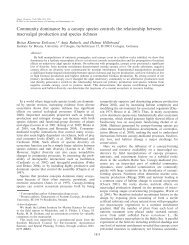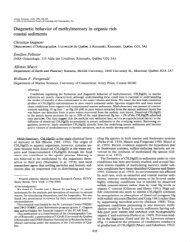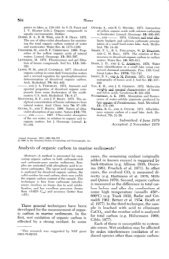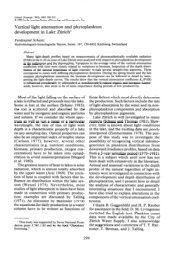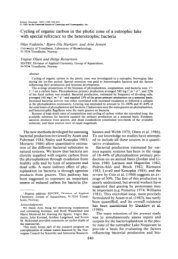Precht, Elimar, and Markus Huettel, Advective pore-water ... - ASLO
Precht, Elimar, and Markus Huettel, Advective pore-water ... - ASLO
Precht, Elimar, and Markus Huettel, Advective pore-water ... - ASLO
Create successful ePaper yourself
Turn your PDF publications into a flip-book with our unique Google optimized e-Paper software.
Wave-driven advection<br />
Fig. 1. The laboratory wave tank (light gray, sealed off <strong>water</strong> volume; dark gray, experimental<br />
<strong>water</strong> volume; WP, wave paddle; AB, artificial beach).<br />
(Shum 1993). These findings demonstrate that the classical<br />
one-dimensional approach frequently used to describe the<br />
distribution of <strong>pore</strong>-<strong>water</strong> constituents <strong>and</strong> to assess the related<br />
fluxes across the sediment-<strong>water</strong> interface is inadequate<br />
for s<strong>and</strong>y, permeable sea beds (Shum <strong>and</strong> Sundby 1996).<br />
The potential relevance of wave-induced advective <strong>pore</strong><strong>water</strong><br />
exchange for metabolic processes in permeable shelf<br />
s<strong>and</strong>s may be inferred from results obtained in flume studies<br />
that have addressed advective <strong>pore</strong>-<strong>water</strong> exchange driven<br />
by unidirectional flows. Those studies showed that advective<br />
interfacial fluid transport provides a rapid pathway for suspended<br />
organic particles <strong>and</strong> phytoplankton cells into permeable<br />
sediments (<strong>Huettel</strong> et al. 1996; <strong>Huettel</strong> <strong>and</strong> Rusch<br />
2000). Simultaneously, oxygen can be transported advectively<br />
deep into the bed (Shum 1993; Ziebis et al. 1996),<br />
which enhances the mineralization of this material (Forster<br />
et al. 1996). The advectively induced <strong>pore</strong>-<strong>water</strong> flow field<br />
in sediment generates a complex biogeochemical zonation<br />
with areas of enhanced nitrification or iron precipitation <strong>and</strong><br />
vertical channels through which ammonium <strong>and</strong> reduced<br />
metals are transported to the sediment surface (<strong>Huettel</strong> et al.<br />
1998).<br />
The aim of the present study was to characterize <strong>and</strong> quantify<br />
the effects of surface gravity waves on fluid exchange<br />
between a s<strong>and</strong>y bed <strong>and</strong> the overlying <strong>water</strong> column <strong>and</strong> to<br />
investigate the mechanisms leading to wave-induced interfacial<br />
exchanges. To achieve this, a set of laboratory wavetank<br />
experiments was conducted with s<strong>and</strong>y sediment<br />
stained with the conservative soluble tracer Rhodamine WT.<br />
The use of Rhodamine WT allowed the synchronous quantification<br />
of the interfacial flux <strong>and</strong> visualization of the<br />
evolving <strong>pore</strong>-<strong>water</strong> flow pattern.<br />
Materials <strong>and</strong> methods<br />
Wave-tank setup—Four experiments (experiments [Exp]<br />
1–4) were carried out in a laboratory wave tank. The wave<br />
tank was made of clear acrylic <strong>and</strong> had an open channel<br />
section of 520 cm length with rectangular cross-section (50<br />
cm high � 47 cm wide). Two acrylic boxes (‘‘upstream’’<br />
box, 240 cm long <strong>and</strong> ‘‘downstream’’ box, 120 cm long;<br />
both 19 cm high <strong>and</strong> spanning the width of the channel)<br />
were placed into the open channel section, such that the<br />
opening between the two boxes enclosed a section of 120<br />
cm length that could be filled with sediment (Fig. 1). Waves<br />
were generated at the upstream end of the wave tank with a<br />
1675<br />
paddle driven by an electric motor. The wave amplitude was<br />
controlled by the stroke of the eccentric, <strong>and</strong> the wave frequency<br />
could be adjusted via the motor speed. This setup<br />
permitted the reproducible generation of sinusoidal waves of<br />
selected amplitude <strong>and</strong> frequency. At the downstream end of<br />
the wave tank, the dissipation of the waves was achieved by<br />
an artificial beach made of an acrylic wedge of 1 m length<br />
that caused the waves to run up <strong>and</strong> break. In Exps 3 <strong>and</strong><br />
4, this wedge was additionally covered by a 10-cm-thick mat<br />
of highly permeable plastic foam, to maximize the dissipation<br />
of the wave energy. The open channel section was<br />
sealed from the other parts of the wave tank <strong>and</strong> from the<br />
two inset acrylic boxes, to prevent loss of the tracer into<br />
those sections.<br />
All experiments were conducted with propagating waves.<br />
Amplitudes, wavelengths, <strong>and</strong> frequencies are listed in Table<br />
1. The hydrodynamic conditions in Exps 3 <strong>and</strong> 4 were identical.<br />
Sediment preparation <strong>and</strong> sampling—The experimental<br />
sediment was cleaned, <strong>and</strong> sieved, dry quartz s<strong>and</strong> originating<br />
from the Weser river estuary (in northern Germany) with<br />
a grain size distribution of 100–300 �m <strong>and</strong> was mixed with<br />
Rhodamine WT tracer solution, which gave it a pink appearance.<br />
The initial tracer concentrations for the respective<br />
experiments are listed in Table 1. The saturated pink sediment<br />
was inserted into the trough enclosed by the two acrylic<br />
boxes, to produce a sediment layer of 25 (Exp 1) or 22<br />
(Exps 2–4) cm depth with 141 <strong>and</strong> 124 dm 3 volume, respectively.<br />
The two boxes in the open channel section were<br />
covered with 6 (Exp 1) or 3 (Exps 2–4) cm of unstained<br />
s<strong>and</strong> of identical grain size. The sediment was compacted<br />
by the application of low-frequency vibration, <strong>and</strong> the surface<br />
was carefully smoothed before each experiment, to create<br />
an overall even surface with uniform roughness in the<br />
open channel section. Ripple evolution occurred as a response<br />
of the bed to the applied wave action.<br />
The use of Rhodamine WT as a tracer to stain the sediments<br />
had two functions. First, sequential <strong>water</strong> sampling<br />
during the experiments <strong>and</strong> subsequent analysis of the tracer<br />
content of the samples allowed the assessment of the flux of<br />
<strong>pore</strong> <strong>water</strong> from the sediment over time. Second, the red<br />
color of Rhodamine WT allowed direct observation of the<br />
evolving <strong>pore</strong>-<strong>water</strong> flow patterns in the sediment.<br />
Directly before <strong>and</strong> after each wave-tank experiment, sediment<br />
subcores of 2.6 cm diameter <strong>and</strong> 10 cm length were



